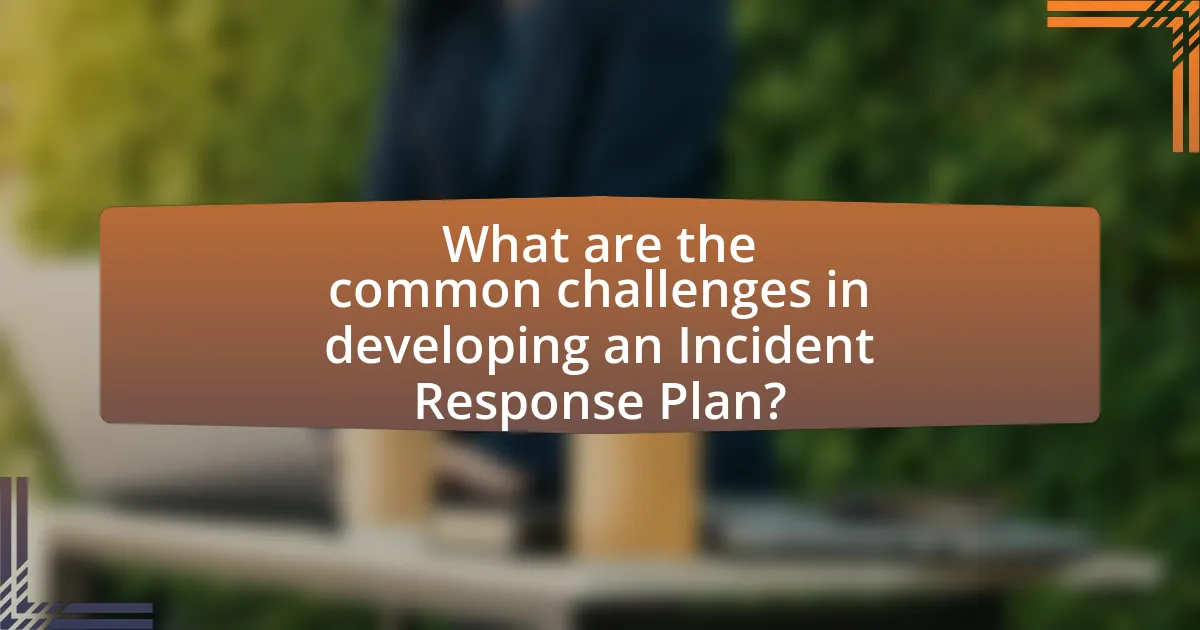An Incident Response Plan (IRP) is a crucial strategy for small businesses, detailing how to prepare for, detect, respond to, and recover from cybersecurity incidents. This article outlines the importance of having an IRP, the types of incidents small businesses should prepare for, and the key components that make an effective plan. It also discusses the roles and responsibilities within the response team, the significance of structured communication during incidents, and best practices for continuous improvement of the plan. Additionally, it highlights common challenges faced by small businesses in developing their IRP and provides resources for guidance in enhancing their cybersecurity posture.

What is an Incident Response Plan for Small Businesses?
An Incident Response Plan for small businesses is a documented strategy that outlines how to prepare for, detect, respond to, and recover from cybersecurity incidents. This plan typically includes specific roles and responsibilities, communication protocols, and procedures for identifying and mitigating threats. According to the National Institute of Standards and Technology (NIST), having a structured incident response plan can significantly reduce the impact of security breaches, as it enables businesses to respond quickly and effectively, minimizing downtime and potential financial losses.
Why is an Incident Response Plan essential for small businesses?
An Incident Response Plan is essential for small businesses because it provides a structured approach to managing and mitigating security incidents. This plan helps small businesses quickly identify, respond to, and recover from cyber threats, minimizing potential damage and financial loss. According to a report by the Ponemon Institute, organizations with an incident response plan can reduce the cost of a data breach by an average of $14 per compromised record. Additionally, having a well-defined plan enhances a business’s ability to comply with regulatory requirements, thereby avoiding potential fines and legal issues.
What types of incidents should small businesses prepare for?
Small businesses should prepare for incidents such as data breaches, cyberattacks, natural disasters, workplace accidents, and supply chain disruptions. Data breaches can compromise sensitive customer information, with 43% of cyberattacks targeting small businesses, according to a 2021 report by Verizon. Cyberattacks, including ransomware, can halt operations and lead to significant financial losses. Natural disasters, like floods or fires, can damage physical assets and disrupt business continuity. Workplace accidents can result in injuries, leading to legal liabilities and increased insurance costs. Lastly, supply chain disruptions can affect product availability and customer satisfaction, emphasizing the need for contingency planning.
How can an Incident Response Plan mitigate risks?
An Incident Response Plan mitigates risks by providing a structured approach to identifying, responding to, and recovering from security incidents. This structured approach enables organizations to minimize the impact of incidents, reduce recovery time, and limit financial losses. For instance, a study by the Ponemon Institute found that organizations with an established incident response plan can reduce the average cost of a data breach by approximately $1.23 million compared to those without such a plan. By outlining clear roles, responsibilities, and procedures, an Incident Response Plan ensures that teams can act swiftly and effectively, thereby decreasing the likelihood of prolonged disruptions and reputational damage.
What are the key components of an effective Incident Response Plan?
An effective Incident Response Plan (IRP) includes key components such as preparation, detection and analysis, containment, eradication, recovery, and post-incident review. Preparation involves establishing policies, procedures, and training for the response team. Detection and analysis focus on identifying and assessing incidents through monitoring and reporting mechanisms. Containment strategies aim to limit the impact of the incident, while eradication involves removing the threat from the environment. Recovery ensures that systems are restored to normal operations, and post-incident review provides insights for improving future responses. These components are essential for minimizing damage and ensuring a swift recovery, as evidenced by the National Institute of Standards and Technology (NIST) guidelines, which emphasize the importance of a structured approach to incident management.
What roles and responsibilities should be defined in the plan?
The roles and responsibilities that should be defined in the incident response plan include the Incident Response Team Leader, who coordinates the response efforts; the Incident Response Team Members, who execute specific tasks during an incident; the Communication Officer, who manages internal and external communications; and the IT Security Specialist, who assesses and mitigates technical threats. Each role is essential for ensuring a structured and effective response to incidents, as outlined in the National Institute of Standards and Technology (NIST) Special Publication 800-61, which emphasizes the importance of clearly defined roles in incident management for organizational efficiency and effectiveness.
How should communication be structured during an incident?
Communication during an incident should be structured in a clear, concise, and hierarchical manner. This involves establishing a designated incident commander who oversees the communication flow, ensuring that information is disseminated promptly to all relevant stakeholders, including team members, management, and external parties such as law enforcement or media if necessary.
Effective communication should utilize predefined channels, such as secure messaging apps or incident management software, to maintain clarity and prevent misinformation. Regular updates should be scheduled to inform all parties of the incident’s status, actions taken, and next steps, fostering transparency and coordination.
Research indicates that organizations with structured communication protocols during incidents experience 30% faster resolution times, highlighting the importance of clarity and organization in crisis management.
What steps are involved in developing an Incident Response Plan?
The steps involved in developing an Incident Response Plan include preparation, identification, containment, eradication, recovery, and lessons learned. Preparation involves establishing an incident response team and defining roles and responsibilities. Identification requires detecting and confirming incidents through monitoring and reporting mechanisms. Containment focuses on limiting the impact of the incident, while eradication involves removing the cause of the incident. Recovery entails restoring systems and services to normal operations, and lessons learned involve reviewing the incident to improve future response efforts. These steps are essential for effectively managing incidents and minimizing damage in small businesses.
How can small businesses assess their current security posture?
Small businesses can assess their current security posture by conducting a comprehensive security audit that evaluates their existing policies, procedures, and technologies. This audit should include identifying vulnerabilities through risk assessments, reviewing access controls, and analyzing incident response capabilities. According to the National Institute of Standards and Technology (NIST), a structured approach to security assessments helps organizations understand their security strengths and weaknesses, enabling them to prioritize improvements effectively.
What processes should be established for incident detection and analysis?
Establishing processes for incident detection and analysis involves implementing continuous monitoring, establishing clear reporting protocols, and utilizing advanced analytics tools. Continuous monitoring ensures real-time detection of anomalies and potential incidents, which is critical for timely response. Clear reporting protocols facilitate swift communication of incidents among team members, ensuring that all relevant stakeholders are informed and can act accordingly. Advanced analytics tools, such as machine learning algorithms, enhance the ability to analyze data patterns and identify threats, thereby improving the accuracy of incident detection. These processes are validated by studies indicating that organizations with robust incident detection frameworks experience significantly reduced response times and lower overall impact from security incidents.

How can small businesses implement their Incident Response Plan?
Small businesses can implement their Incident Response Plan by establishing a clear framework that includes preparation, detection, analysis, containment, eradication, recovery, and post-incident review. This structured approach ensures that all aspects of incident management are addressed systematically. For instance, according to the National Institute of Standards and Technology (NIST), a well-defined incident response process enhances an organization’s ability to manage incidents effectively, reducing potential damage and recovery time. By training employees on their roles within the plan and conducting regular drills, small businesses can ensure readiness and improve response times during actual incidents.
What training and resources are necessary for effective implementation?
Effective implementation of an incident response plan in small businesses requires comprehensive training and access to relevant resources. Training should include cybersecurity awareness, incident response protocols, and hands-on simulations to prepare staff for real-world scenarios. Resources necessary for effective implementation encompass incident response tools, communication platforms, and access to cybersecurity experts or consultants. For instance, the National Institute of Standards and Technology (NIST) provides guidelines and frameworks that can serve as valuable resources for developing and implementing incident response plans.
How often should training sessions be conducted?
Training sessions should be conducted at least quarterly for effective incident response in small businesses. This frequency allows teams to stay updated on new threats and response strategies, ensuring preparedness. Research indicates that regular training enhances retention of information and skills, with studies showing that organizations conducting quarterly training sessions experience a 50% improvement in incident response times compared to those with less frequent training.
What tools can assist in the implementation of the plan?
Tools that can assist in the implementation of an incident response plan in small businesses include incident management software, communication platforms, and training programs. Incident management software, such as ServiceNow or Jira, helps streamline the response process by tracking incidents and automating workflows. Communication platforms like Slack or Microsoft Teams facilitate real-time collaboration among team members during an incident. Additionally, training programs, including tabletop exercises and simulations, prepare staff to effectively execute the plan. These tools enhance coordination, improve response times, and ensure that all team members are equipped to handle incidents efficiently.
How can small businesses test their Incident Response Plan?
Small businesses can test their Incident Response Plan by conducting tabletop exercises, which simulate an incident scenario to evaluate the effectiveness of the plan. These exercises involve key team members discussing their roles and responses in a controlled environment, allowing for identification of gaps and areas for improvement. According to a study by the Ponemon Institute, organizations that regularly test their incident response plans are 50% more likely to effectively manage incidents, highlighting the importance of practical testing in enhancing preparedness and response capabilities.
What types of drills and simulations are recommended?
Recommended types of drills and simulations include tabletop exercises, functional exercises, and full-scale simulations. Tabletop exercises involve key personnel discussing their roles and responses to a simulated incident, which helps identify gaps in the incident response plan. Functional exercises test specific components of the plan in a controlled environment, allowing teams to practice their skills and coordination. Full-scale simulations replicate real-life scenarios, engaging all relevant personnel and resources, which enhances preparedness and response capabilities. These methods are supported by the National Institute of Standards and Technology (NIST), which emphasizes the importance of regular practice to improve response effectiveness.
How can feedback from testing improve the plan?
Feedback from testing can significantly improve the incident response plan by identifying weaknesses and areas for enhancement. When small businesses conduct testing, such as simulations or tabletop exercises, they gather insights on the effectiveness of their response strategies, communication protocols, and resource allocation. For instance, a study by the National Institute of Standards and Technology (NIST) emphasizes that regular testing and feedback loops lead to a more resilient incident response framework, as they allow organizations to adapt their plans based on real-world scenarios and outcomes. This iterative process ensures that the plan evolves to address emerging threats and operational challenges effectively.

What are the common challenges in developing an Incident Response Plan?
Common challenges in developing an Incident Response Plan include insufficient resources, lack of expertise, and inadequate communication. Insufficient resources can hinder the ability to allocate necessary personnel and technology for effective incident response. Lack of expertise often results in poorly designed plans that do not address specific threats, as many small businesses may not have dedicated cybersecurity professionals. Inadequate communication can lead to confusion during an incident, as roles and responsibilities may not be clearly defined, resulting in delayed responses and increased damage. These challenges are frequently cited in industry reports, such as the 2022 Verizon Data Breach Investigations Report, which highlights that many organizations struggle with resource allocation and training in incident response.
What obstacles do small businesses face in creating an effective plan?
Small businesses face several obstacles in creating an effective plan, including limited resources, lack of expertise, and insufficient data. Limited resources often result in inadequate funding and personnel, which hinders the development of comprehensive plans. A lack of expertise means that small business owners may not have the necessary knowledge or experience to identify potential risks and formulate appropriate responses. Additionally, insufficient data can lead to poor decision-making, as businesses may not have access to relevant information about threats or best practices. These challenges collectively impede the ability of small businesses to create robust incident response plans.
How can budget constraints impact the development of the plan?
Budget constraints can significantly limit the resources available for developing an incident response plan. When financial resources are restricted, small businesses may struggle to allocate sufficient funds for essential components such as training, technology, and expert consultations. For instance, a study by the Ponemon Institute found that organizations with limited budgets often lack adequate cybersecurity measures, which can lead to ineffective incident response capabilities. Consequently, budget constraints can result in a less comprehensive plan, increased vulnerability to incidents, and ultimately higher costs associated with breaches or failures in response.
What are the implications of insufficient staff training?
Insufficient staff training leads to increased vulnerability to security incidents and ineffective incident response. When employees lack the necessary skills and knowledge, they may fail to recognize threats, mismanage incidents, or not follow established protocols, resulting in prolonged downtime and potential data breaches. According to a report by IBM, organizations with a well-trained staff can reduce the cost of a data breach by an average of $1.2 million, highlighting the financial impact of inadequate training. Furthermore, insufficient training can lead to decreased employee morale and higher turnover rates, as staff may feel unprepared and unsupported in their roles.
What best practices should small businesses follow when developing their Incident Response Plan?
Small businesses should follow several best practices when developing their Incident Response Plan, including defining roles and responsibilities, establishing communication protocols, and conducting regular training and simulations. Clearly defined roles ensure that team members understand their specific tasks during an incident, which enhances efficiency and reduces confusion. Effective communication protocols facilitate timely information sharing among stakeholders, which is critical for a coordinated response. Regular training and simulations help to prepare the team for real incidents, allowing them to practice their response strategies and identify areas for improvement. According to the National Institute of Standards and Technology (NIST), organizations that conduct regular incident response exercises are better equipped to handle actual incidents, demonstrating the importance of these practices.
How can small businesses ensure continuous improvement of their plan?
Small businesses can ensure continuous improvement of their incident response plan by regularly reviewing and updating the plan based on feedback and lessons learned from past incidents. This process involves conducting post-incident analyses to identify strengths and weaknesses, incorporating new technologies and best practices, and engaging employees in training exercises to enhance their preparedness. Research indicates that organizations that conduct regular reviews and updates of their plans experience a 30% reduction in response time during incidents, demonstrating the effectiveness of continuous improvement in incident management.
What resources are available for small businesses seeking guidance?
Small businesses seeking guidance can access various resources, including government agencies, nonprofit organizations, and online platforms. The U.S. Small Business Administration (SBA) offers a wealth of information, including business planning tools and access to local assistance through Small Business Development Centers (SBDCs). Additionally, organizations like SCORE provide free mentoring and workshops tailored to small business needs. Online resources such as the Federal Trade Commission (FTC) and cybersecurity frameworks from the National Institute of Standards and Technology (NIST) also offer valuable guidance on best practices, particularly in developing incident response plans. These resources are designed to support small businesses in navigating challenges and enhancing their operational resilience.
